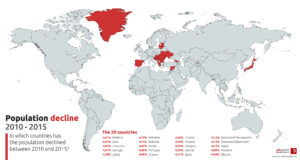 Image Source: Jo Di Graphics (using United Nations data)
Image Source: Jo Di Graphics (using United Nations data)
Declining populations have become the norm in a number of countries in the last few decades. There are of course the occasional cases of war, disasters, and other extraordinary drivers, but there is a number of countries, mostly in Eastern Europe the demographics of which have a systemic decline. Other cases include Japan, which is the front runner among the most developed nations and started experiencing the phenomenon quite early. If the current trends continue, it will be joined by Germany and other Western European nations in the next decades.
Many of these countries share similar drivers and current dynamics. So what are the common potential futures ahead of them and what are the decisions they can make to influence which path on the crossroads they take? Before we answer that, let us look at the common factors and drivers.
There are two immediate drivers in this domain – lower birth rates and migration outflow. What typically stands behind the first are economic and socio-cultural factors. What typically stands behind the second are again economic, but then more open border control and lower immigration/emigration barriers globally. The cases where both drivers are in full force experience the most negative growth (the Baltics and the Balkans). Some of these early cases of population decline can serve as laboratories for countries expected to register declining populations in the future (even China is expected to experience that starting in the 2030s).
There are four typical scenarios (based on the Houston Foresight archetype approach adapted from Jim Dator). Taking Bulgaria as a concrete example, these are:
The Ongoing Slide Down (Baseline/Status-quo): The population of Bulgaria continues to decline with stable or slight smaller rate, with the economy continuing on its current slow but stable convergence path with Europe. This includes a variety of sub-fields such as healthcare, education, and technology sector.
The Irish Scenario (Transformation): The population of Bulgaria reverses the on-going decline and enters a prolonged and continuing increase, with the economy experiencing a similar expansion and boom period, quickly converging and surpassing the EU average. A booming tech sector, remote workers, healthcare and social system immigrants from more developed nation in charter cities prop up the population.
The Stable Populous (New Equilibrium): The population of Bulgaria reverses the on-going decline and enters a stable phase, albeit below the maximum it had in the late 1980s, with the economy experiencing a healthy growth significantly above the EU average. However, long term age pyramid structure problems remain.
The Demographic Catastrophe (Collapse Scenario): The decline of the population of Bulgaria enters into overdrive, with significant additional emigration outflow, deteriorating economy and social systems (healthcare and social security) as well as compounding negative effects of shrinking populous (lower tax base, economic drag).
None of these are a priori good or bad – even the Demographic Catastrophe one could be a desired preferred future if it brings economic prosperity, renewal of arts and entrepreneurship (as in the case of Detroit, MI in the US), or as part of a global sustainability and matching the carrying capacity of the planet. The question in front of decision makers and the general public is how do we prepare for and work towards the most desired future and its alternatives. Answering it is beyond the ambition of this post, but here are several topics that can serve as starting points:
- How can openness and readiness for charter cities impact the scenarios? How will that in turn impact the education needs as well as the construction and housing industry?
- Is it possible to generate an inflow of Foreign Retirees from wealthier to less wealthy countries? How will that in turn impact investment needs in public healthcare institutions, facilities and technology or stimulate private healthcare, and what security and liability policies to regulate a supporting robotic industry would be needed?
- Can a focus on a third-child family policy generate the desired output? How will that in turn impact the population pyramid over time, and what with the be the interplay with potential negative tax and basic income programs?
Efforts of all nations – emerging and developed, poor or wealthy, with declining or growing (but in the future declining) population – should be directed towards exploring this rising trend and how to deal with it in a sustainable manner, while optimizing the wellbeing of the populous. These early cases present a great opportunity to examine that and pioneer solutions on how to manage the process. This will show which path on the crossroads will lead where and ideally inform nations on which one to take. — Ruslan Skomorohov





